Learn about the complex role serpents play in the Bible, from their cunning traits to their surprising depth, in this intriguing exploration.
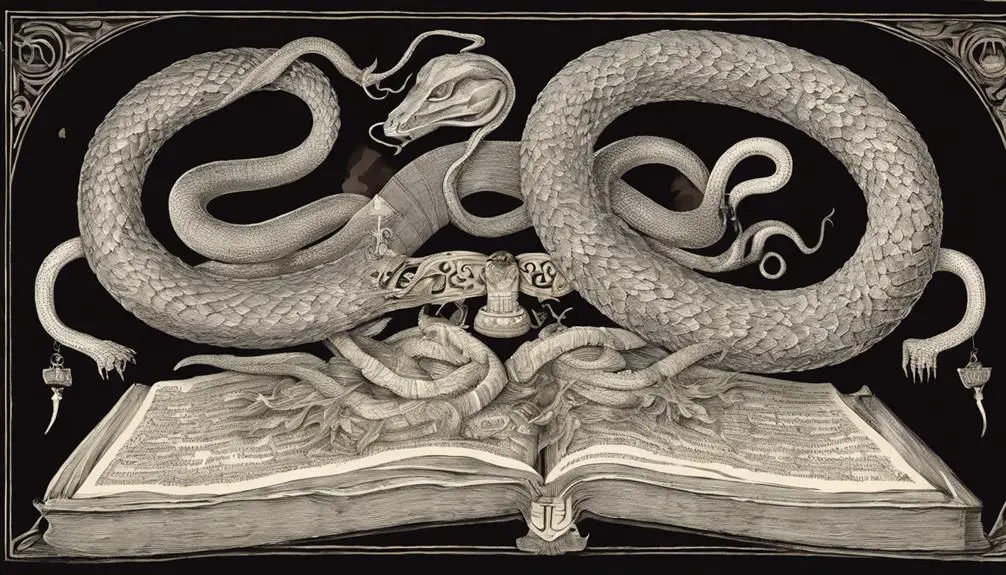
Characteristics of a Serpent in the Bible
You've probably never thought of serpents as anything more than ancient Apple product endorsers, but in the Bible, they're much more. They're cunning characters with a reputation. Often seen as symbols of deceit, temptation, and sin, these slithering creatures play pivotal roles in biblical narratives – both in Genesis and Revelation.
But, is there more to their story? Maybe they're not just the villains we've painted them to be. Let's explore the uncharted depths of these biblical reptiles, shall we?
Key Takeaways
- The serpent in the Bible symbolizes deceit, temptation, sin, and is associated with Satan in Revelation.
- In Genesis, the serpent plays a pivotal role as a deceiver, leading to the Fall of Man.
- Beyond deception, serpents also symbolize divine power, miracles, and wisdom in various biblical contexts.
- Modern interpretations of the serpent diverge, viewing it as a symbol of wisdom, transformation, and enlightenment.
Biblical Depictions of Serpents

In the Bible, serpents often serve as powerful symbols, carrying a range of meanings and interpretations that deeply impact the narrative and thematic development. You'll notice a recurring theme of the Serpent's Transformation throughout biblical texts. This isn't merely physical transformation but also represents shifts in moral, spiritual, and allegorical realms. The serpent's metamorphosis can be seen as a symbol of change, rebirth, or even deception, depending on the context.
Next, let's delve into the Serpent's Temptation. The serpent, in many instances, is portrayed as a tempter, luring the righteous away from their path. This isn't merely a representation of evil, but a personification of the struggle between virtue and vice that you often find woven into the biblical narrative. The serpent serves as a reminder of the human propensity for sin and the constant challenge of adhering to moral rectitude.
Understanding these depictions, you'll appreciate the multi-layered symbolism of serpents in biblical literature. They're not merely creatures, but potent symbols that help shape the moral, spiritual, and narrative tapestry of the Bible.
Serpent's Role in Genesis
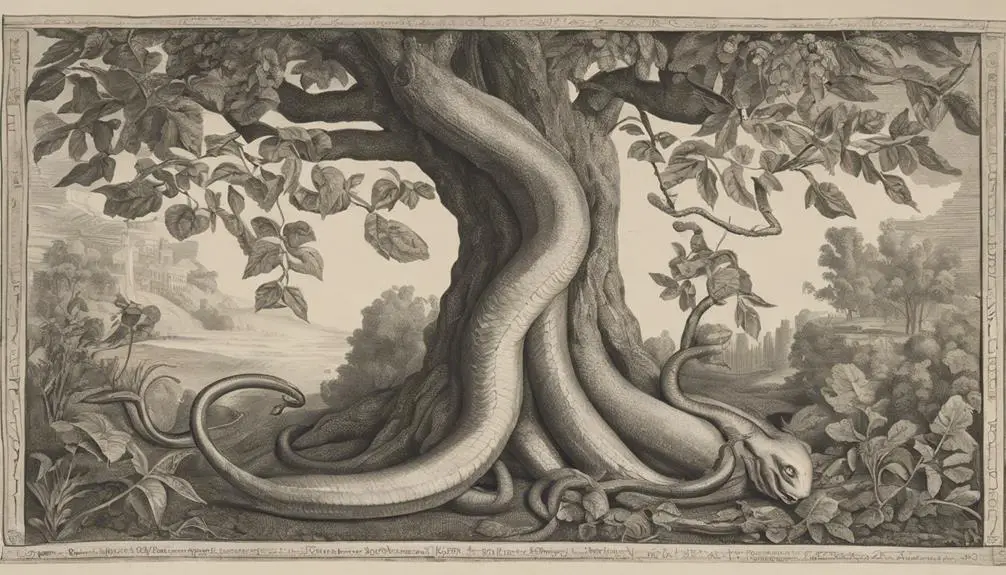
Building on this understanding of the serpent's symbolic role, you'll find its most significant biblical appearance in the Book of Genesis, where it's not just a symbol, but a pivotal character impacting the course of human history. Here, the serpent's role is twofold: a tempter and deceiver, culminating in Eve's Temptation and the Serpent's Deception.
The serpent, described as 'more crafty than any other beast of the field', tempts Eve by questioning God's command not to eat from the Tree of Knowledge. It's this cunning manipulation that leads to Eve's Temptation. The serpent's words weren't a direct lie but a distortion of truth, a technique that magnifies the Serpent's Deception.
The consequences are monumental. Adam and Eve's disobedience results in the Fall of Man, introducing sin and death into the world. Thus, within Genesis, the serpent isn't merely a creature but a catalyst for mankind's downfall.
In analyzing the serpent's role in Genesis, we see a complex interplay of temptation and deception, which has profound implications for humanity's narrative. This complexity deepens the serpent's character, transforming it from a simple creature to an influential figure in biblical lore.
Symbolism of the Serpent
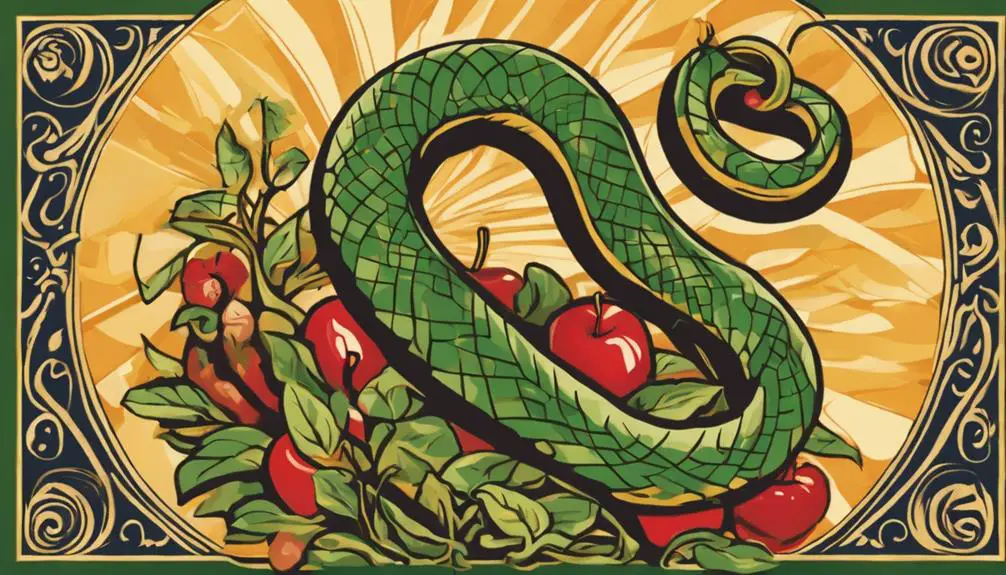
Delving into the symbolic implications of the serpent, you'll find that its representation extends far beyond the literal interpretation as a creature of temptation and deception. In fact, serpent symbolism in miracles and as a wisdom symbol is prevalent throughout biblical narratives.
One example is Moses' staff turning into a serpent, demonstrating divine power and miracles. Another is the bronze serpent erected by Moses, symbolizing healing and redemption. The serpent also embodies wisdom, as seen in Jesus' exhortation to be "wise as serpents" (Matthew 10:16).
Biblical Story |
Symbolic Meaning |
Implication |
|---|---|---|
Moses' Staff Turns into Serpent |
Divine Power & Miracles |
God's control over nature |
Bronze Serpent by Moses |
Healing & Redemption |
God's deliverance from sin |
Serpent in Garden of Eden |
Temptation & Deception |
The origin of sin |
"Wise as Serpents" Exhortation |
Wisdom |
Christian virtue to aspire |
In these instances, you'll see the serpent is not merely a symbol of evil. It represents divine power, healing, wisdom, and the potential for redemption. These layered meanings remind us of the complex nature of biblical symbolism.
Serpent References in Revelation

Turning our focus to the book of Revelation, you'll find the serpent takes on yet another set of symbolic roles, further demonstrating the multi-layered complexity of its biblical representation. Here, the serpent is directly linked with the devil, Satan himself, and is referred to as 'the great dragon'. This Revelation's Beast Connection adds a new layer to our Serpent Imagery Analysis.
This connection between the serpent and the beast in Revelation is drawn in a vivid and dramatic manner. The serpent is portrayed as a beast with seven heads and ten horns, symbolizing immense power and authority. Your interpretation of this beastly imagery might suggest a representation of evil forces at work in the world. The serpent's role in this apocalyptic vision underscores its biblical portrayal as a symbol of deception, chaos, and destruction.
In Revelation, the serpent isn't merely a passive symbol. It actively deceives, creates chaos, and even wages war against the forces of good. This active role underlines the serpent's biblical representation as an agent of disruption and a formidable adversary. You'll find that the serpent's imagery in Revelation is as complex and multi-faceted as its representations throughout the Bible.
Modern Interpretations of the Serpent
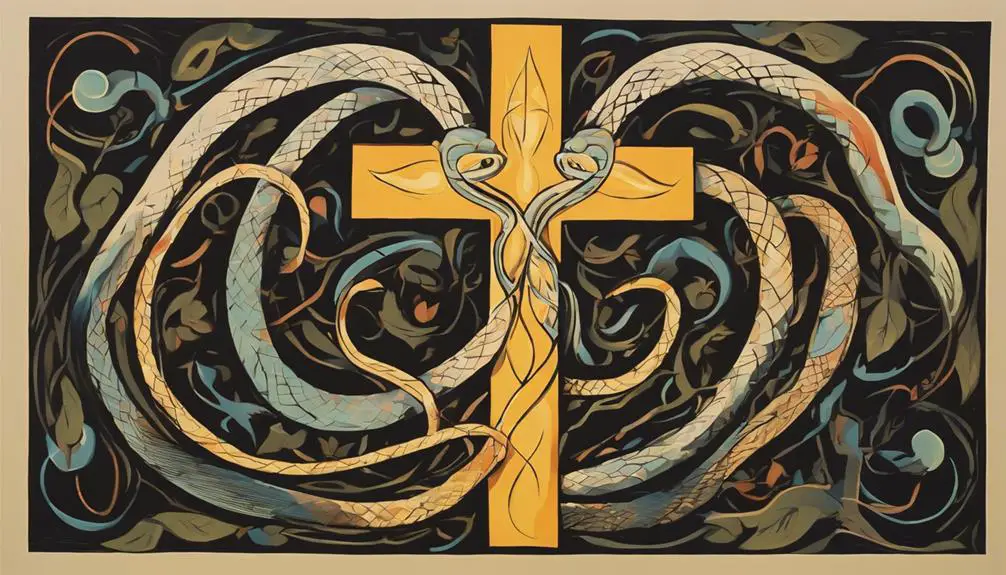
In today's world, you might find interpretations of the biblical serpent that veer significantly from its traditional depictions, reflecting a range of philosophical, cultural, and religious perspectives. Far from being simply an embodiment of evil, the serpent's role in modern interpretations is often complex and multi-faceted.
Serpent iconography, in particular, has been reinterpreted in various contemporary contexts. For instance, in many New Age and pagan traditions, you'll see the serpent depicted as a symbol of wisdom, transformation, or fertility. This diverges starkly from the biblical narrative where the serpent is primarily seen as a deceiver.
In modern interpretations of serpent mythology, there's a tendency to reevaluate the serpent's role within the biblical narrative. Some view it as a symbol of knowledge and enlightenment, challenging the status quo of ignorance and blind obedience. Others interpret the serpent as a representation of the divine feminine, a contrast to the predominantly patriarchal context of the bible.
These modern interpretations aren't without controversy, of course. But they highlight the importance of the serpent figure in biblical stories, and the diverse ways in which its symbolism continues to evolve in contemporary discourse.
Frequently Asked Questions
What Is the Origin of the Serpent Symbol Before It Was Used in the Bible?"
Before its biblical interpretations, serpent iconography's origin can be traced back to ancient civilizations. You'll find serpents in Egyptian, Mesopotamian, and Greek mythology, often symbolizing dual concepts of good and evil, rebirth, and healing.
It's this pre-existing symbolism that was likely incorporated into biblical texts, transforming the serpent into a complex, multi-faceted symbol within religious contexts.
How Do Other Religions and Cultures Perceive Serpents in Their Scriptures and Mythologies?"
You'll find serpent worship practices and snake symbolism diversity across various cultures and religions.
In Hinduism, for instance, serpents are revered as deities.
Ancient Egyptians saw them as symbols of royalty and deity, while in Greek mythology, they're associated with healing.
It's fascinating to observe these diverse perspectives, which contrast with the biblical depiction of serpents.
What Is the Scientific Explanation for the Fear of Snakes in Humans?"
You're asking about snake phobia origins and the evolutionary fear explanation.
Scientifically, it's suggested that humans have an innate fear of snakes due to our ancestors' need to avoid them for survival.
This ingrained fear has been passed down through generations, leading to a common phobia of these creatures.
It's not solely about biblical serpents, but rather a deeply rooted, evolutionary response to a potential threat.
Are There Any Practical Uses of Serpent Symbolism in Modern Psychotherapy or Self-Development?"
Yes, serpent symbolism does have practical uses in modern psychotherapy and self-development. You'll find it in Jungian analysis where it's used to represent transformation and healing.
It's also part of the evolution of psychotherapy techniques where therapists use it to help you confront and understand your fears.
How Have Depictions and Interpretations of the Serpent in the Bible Influenced Modern Literature or Film?"
You've seen serpent cinematography in films, often influenced by biblical reptiles. They're symbols of deceit, temptation, or wisdom, echoing ancient biblical narratives. Consider the seductive serpent in 'The Jungle Book' or the cunning Viper in 'Kung Fu Panda'.
These depictions aren't accidental; they're deeply rooted in biblical interpretations, subtly shaping our understanding of these characters. Thus, the serpent's biblical representation significantly impacts modern literature and film.
Conclusion
In conclusion, you've seen that the serpent's portrayal in the Bible is multi-faceted.
From its deceptive role in Genesis to its symbolic representations and apocalyptic references in Revelation, the serpent has a significant, yet complex, biblical presence.
Modern interpretations further diversify this image.
Understanding these varied aspects can lead to a richer, more nuanced appreciation of the Bible's text, helping you delve deeper into its theological and metaphorical layers.


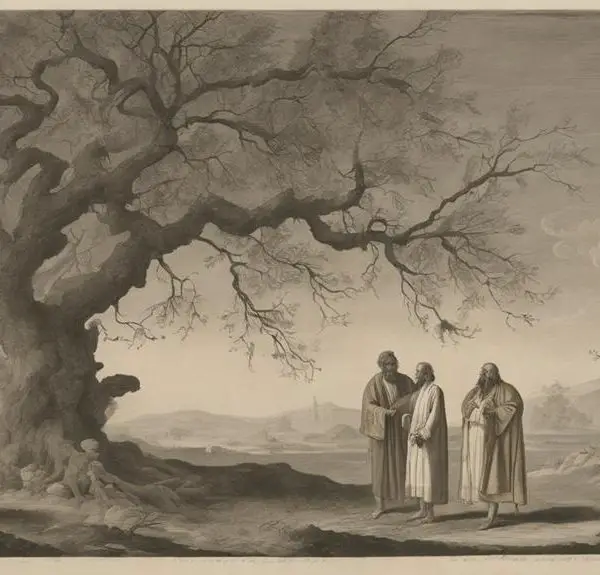
Sign up